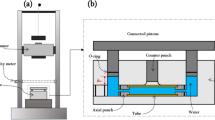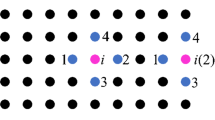Abstract
It is common knowledge that conventional finite element method (FEM) has intrinsic limitations in analyzing large deformation problems like high-velocity impact, explosion, etc. because of mesh distortion and tangling; while these problems can be easily avoided by the meshfree method (MM), the latter involves greater computation time. Therefore, in this article, in order to simultaneously utilize the respective advantages of the two methods, a coupled simulation method between both FEM and MM was employed to analyze the high-velocity impact on ductile metal pipe with polymer coating. The impacted area with large deformation was discretized by SPH (smoothed particle hydrodynamics) particles, a classic meshfree model, and the remaining section was modeled by FEM meshes. By this method, the interfacial shear stresses between the coating and the substrate and the residual stresses beneath the contact points were studied, which would have referenced values in analyzing failure modes of components with similar composite structure. Then, the results were compared with sole FEM and MM too.






Similar content being viewed by others
References
Gong, Y., Yang, Z.G., Yuan, J.Z.: Failure analysis of leakage on titanium tubes within heat exchangers in a nuclear power plant. Part II. Mechanical degradation. Mater. Corros. 63, 18–28 (2012)
Gong, Y., Zhong, J., Yang, Z.G.: Failure analysis of bursting on the inner pipe of a jacketed pipe in a tubular heat exchanger. Mater. Des. 31, 4258–4268 (2010)
Wood, R.J.K.: The sand erosion performance of coatings. Mater. Des. 20, 179–191 (1999)
Hutchings, I.M.: Particle erosion of ductile metals: a mechanism of material removal. Wear 27, 121–128 (1974)
Hutchings, I.M.: Ductile-brittle transitions and wear maps for the erosion and abrasion of brittle materials. J. Phys. D Appl. Phys. 25, A212–A221 (1992)
Barkoula, N.M., Karger-Kocsis, J.: Review processes and influencing parameters of the solid particle erosion of polymers and their composites. J. Mater. Sci. 37, 3807–3820 (2002)
Shimizu, K., et al.: FEM analysis of the dependency on impact angle during erosive wear. Wear 233–235, 157–159 (1999)
Chen, Q., Li, D.Y.: Computer simulation of solid particle erosion. Wear 254, 203–210 (2003)
Zouari, B., Touratier, M.: Simulation of organic coating removal by particle impact. Wear 253, 488–497 (2002)
Har, J., Fulton, R.E.: A parallel finite element procedure for contact-impact problems. Eng. Comput. 19, 67–84 (2003)
Griffin, D., Daadbin, A., Datta, S.: The development of a three-dimensional finite element model for solid particle erosion on an alumina scale/MA956 substrate. Wear 256, 900–906 (2004)
Aquaro, D.: Erosion due to the impact of solid particles of materials resistant at high temperature. Meccanica 41, 539–551 (2006)
Nguyen, V.P., Rabczuk, T., Bordas, S., Duflot, M.: Meshless methods: a review and computer implementation aspects. Math. Comput. Simulat. 79, 763–813 (2008)
Rabczuk, T., Belytschko, T.: Cracking particles: a simplified meshfree method for arbitrary evolving cracks. Int. J. Numer. Methods Eng. 61, 2316–2343 (2004)
Rabczuk, T., Belytschko, T.: A three-dimensional large deformation meshfree method for arbitrary evolving cracks. Comput. Method Appl. M 196, 2777–2799 (2007)
Rabczuk, T., Gracie, R., Song, J.H., Belytschko, T.: Immersed particle method for fluid–structure interaction. Int. J. Numer. Methods Eng. 81, 48–71 (2010)
Zeng, X.W., Li, S.F.: A multiscale cohesive zone model and simulations of fracture. Comput. Methods Appl. Mech. Eng. 199, 547–556 (2010)
Ren, B., Li, S.F.: Meshfree simulations of plugging failures in high-speed impacts. Comput. Struct. 88, 909–923 (2010)
Lucy, L.B.: A numerical approach to the testing of the fission hypothesis. Astron. J. 8, 1013–1024 (1977)
Gingold, R.A., Monaghan, J.J.: Smoothed particle hydrodynamics: theory and application to non-spherical stars. Mon. Not. R. Astr. Soc. 181, 375–389 (1977)
Nayroles, B., Touzot, G., Villon, P.: Generalizing the elements. Comput. Mech. 10, 307–318 (1992)
Belytschko, T., Lu, Y.Y., Gu, L.: Element-free Galerkin methods. Int. J. Numer. Methods Eng. 37, 229–256 (1994)
Liu, W.K., Jun, S., Zhang, Y.F.: Reproducing kernel particle methods. Int. J. Numer. Methods Fluids 20, 1081–1106 (1995)
Liu, W.K., Li, S.F., Belytschko, T.: Moving least-square reproducing kernel methods (I). Methodology and convergence. Comput. Method Appl. M 143, 113–154 (1997)
Li, S.F., Liu, W.K.: Moving least-square reproducing kernel method. Part II. Fourier analysis. Comput. Method Appl. M 139, 159–193 (1996)
Huera, A., Fernandez-Mendez, S.: Enrichment and coupling of the finite element and meshless methods. Int. J. Numer. Mech. Eng. 48, 1615–1636 (2000)
Wu, C.T., Botkin, M.E., Wang, H.P.: Development of a coupled finite element and mesh-free method in LS-DYNA. In: 7th International LS-DYNA Users Conference, Dearborn, Michigan, pp. 1229–1240 (2002)
Rabczuk, T., Xiao, S.P., Sauer, M.: Coupling of meshfree methods with finite elements: basic concepts and test results. Commun. Numer. Methods Eng. 22, 1031–1065 (2006)
Wang, H.P., Wu, C.T., Guo, Y., Botkin, M.E.: A coupled meshfree/finite element method for automotive crashworthiness simulations. Int. J. Impact Eng. 36, 1210–1222 (2009)
Johnson, G.R., Beissel, S.R., Gerlach, C.A.: Another approach to a hybrid particle-finite element algorithm for high-velocity impact. Int. J. Impact Eng. 38, 397–405 (2011)
Wang, Y.F., Yang, Z.G.: A coupled finite element and meshfree analysis of erosive wear. Tribol. Int. 42, 373–377 (2009)
Holmberg, K., Matthews, A., Ronkainen, H.: Coatings tribology-contact mechanisms and surface design. Tribol. Int. 31, 107–120 (1998)
Johnson, G.R., Cook, W.H.: A constitutive model and data for metals subjected to large strains, high strain rates and high temperatures. In: Proceedings of the 7th International Symposium on Ballistics, The Hague, pp. 541–547 (1983)
Johnson, G.R., Cook, W.H.: Fracture characteristics of three metals subjected to various strains, strain rates, temperatures and pressures. Eng. Fract. Mech. 21, 31–48 (1985)
Kay, G.: Failure Modeling of Titanium 6Al–4V and Aluminum 2024-T3 with the Johnson–Cook Material Model. Tech. Rep. DOT/FAA/AR-03/57. US Department of Transportation, Federal Aviation Administration (2003)
Torres, M., Voorwald, H.: An evaluation of shot peening, residual stress and stress relaxation on the fatigue life of AISI 4340 steel. Int. J. Fatigue 24, 877–886 (2002)
Acknowledgments
This study was supported by the Shanghai Leading Academic Discipline Project (Project Number: B113). Meanwhile, Yi Gong also appreciate the help from Professor Shaofan Li’s research group in Department of Civil and Environmental Engineering at University of California, Berkeley under the Short-term International Exchange Programme Fund for Doctoral Students of Fudan University.
Author information
Authors and Affiliations
Corresponding author
Rights and permissions
About this article
Cite this article
Gong, Y., Yang, ZG. & Wang, YF. Impact Simulation on Ductile Metal Pipe with Polymer Coating by a Coupled Finite Element and Meshfree Method. J Fail. Anal. and Preven. 12, 267–272 (2012). https://doi.org/10.1007/s11668-012-9555-3
Received:
Revised:
Published:
Issue Date:
DOI: https://doi.org/10.1007/s11668-012-9555-3




